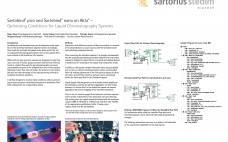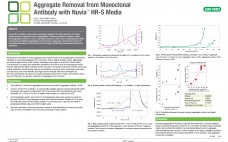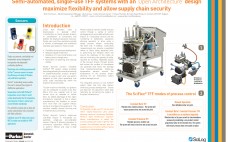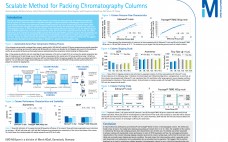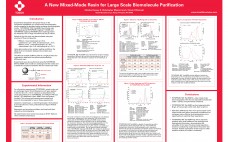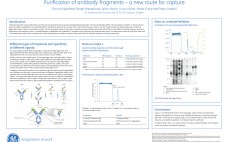Sartobind pico and Sartobind nano are the laboratory-scale mem-bers of the Sartobind membrane adsorber family. Accordingly, their small size and high throughput make them perfect for use on automated chromatography systems such as the popular Akta series offered by GE Healthcare Life Sciences.While both the pico and nano capsules are designed for high flow rates, the array of valves, pumps, monitors and the flow restrictor found in a typical flow path for gel chromatography can cause unacceptable pressures at the…
Downstream Processing
Platform Purification of a Domain Antibody
Monoclonal antibodies (MAbs) are very successful for treatment of several different cancers and tumors. However, the low tissue penetration has led to the development of smaller sized biopharmaceuticals (Ab fragments) such as Fabs, single chain Fv (scFv) and domain antibodies (Dabs). These molecules lack the Fc part of the antibody making a platform purification approach using Protein A impossible. However, with the introduction of the Protein L based affinity chromatography media (Capto™ L) new possibilities are introduced for capture of…
Aggregate Removal from Monoclonal Antibody with Nuvia™ HR-S Media
Nuvia HR-S media is a new cation exchanger designed for high resolution of closely related product impurities such as aggregates. It delivers excellent resolution, with a final aggregate content of <0.3%, and high recovery of >80% from a heterogeneous feed of monoclonal antibody aggregates and monomer. Aggregate content and recovery in the eluate were shown to be functions of the target conductivity measured at the end of collection.
A Case Study: 3-step Process for Efficient mAb Purification
This study showcases a portfolio of commercially available biopharmaceutical chromatography resins designed for the efficient purification of monoclonal antibodies. A 3-step purification process has been implemented which showed effective removal of the main contaminants, low ligand leakage, and high yields over the entire process. Eshmuno® A affinity chromatography resin was evaluated as the first step in the process. The Protein A elution pool was further purified using cation exchange chromatography. Two cation exchange resins with different selectivities were compared. The…
Semi-automated, Single-use TFF Systems With an ‘Open Architecture’ Design Maximize Flexibility and Allow Supply Chain Security
Cross flow filtration used in bioprocesses is typically either microfiltration to clarify process streams or ultrafiltration to concentrate and diafilter the biopharmaceutical molecule. Single-use cross flow operations provide a number of advantages over traditional stainless steel systems. These include: • Flexibility during process development • Reduced capital investment • Avoidance of cross contamination and faster product change overs • Elimination of steaming and cleaning utilities Parker domnick hunter’s innovative SciFlex® TFF system utilizes propriety technology allowing the sterile processing of…
Scalable Method for Packing Chromatography Columns
Currently the bio-pharmaceutical industry is heading towards cost cutting, time saving and single use manufacturing approach. This has opened up a whole new market for disposable technologies. Pre-packed disposable chromatography columns are a best fit for preclinical and clinical stage Monoclonal Antibody (mAb) production and vaccine manufacturing processes which require quick turnaround times and aggressive validation respectively. This work describes development of pre-packed and ready to use chromatography columns to meet this need in the industry. A robust packing method…
A New Mixed-Mode Resin for Large Scale Biomolecule Purification
Chromatographic resins with high capacities and selectivities differing from those seen with traditional hydrophobic interaction and ion exchange media are now in demand. Mixed-mode chromatography media is an alternative. Some mixed-mode resins combine both traditional hydrophobic interaction and ion exchange media. This poster introduces TOYOPEARL® MX-Trp-650M, a high-capacity weak cation mixed-mode resin for the purification of biomolecules. The polymethacrylic base bead was chemically modified with the amino acid tryptophan which combines a weak cationic group with a hydrophobic functional group.…
Sartopore (R) Platinum Sterile Filtration, Redefined
We introduce a new class of Sterile Filtration for Biopharmaceutical industry with Sartopore® Platinum. It offers exceptional total throughput, thanks to its patent-pending TwinPleat technology with 1 m2 area/10” element. At the heart of Sartopore® Platinum are PES membranes permanently hydrophilized with proprietary grafting of thermally stable polymer on to membrane surfaces. This leads to minimal wetting requirements prior to Integrity testing with < 5 L./10” preflush needed in < 1 min. They also offer low Protein Binding and low…
Purification of Antibody Fragments: A New Route for Capture
Antibody fragments have the potential to become the next important class of protein-based biotherapeutics after monoclonal antibodies (MAbs). The introduction of Capto™ L, with its protein L ligand, provides a possibility for an industrial platform purification approach for capture of this class of biomolecules. Capto L can bind a broad range of antibody fragments containing kappa light chains. Capto L is the latest member of chromatographic media (resins) in the toolbox consisting of several different products with affinity for the…
Comparison of Commercial Kits for Extraction of Residual Host Cell DNA
Expression of therapeutic proteins in cultured cells is a cost effective method for production of commercial quantities of a drug substance. However, the manufacturing and purification process of these products leaves the potential for DNA contamination from the host cells. Due to the theoretical potential for the transfer of oncogenes from the host cell, the WHO has set a residual host cell DNA limit of 10ng/dose in biologic therapeutics. Regulatory agencies have set allowable limits between 100pg/dose and 10ng/dose depending…

